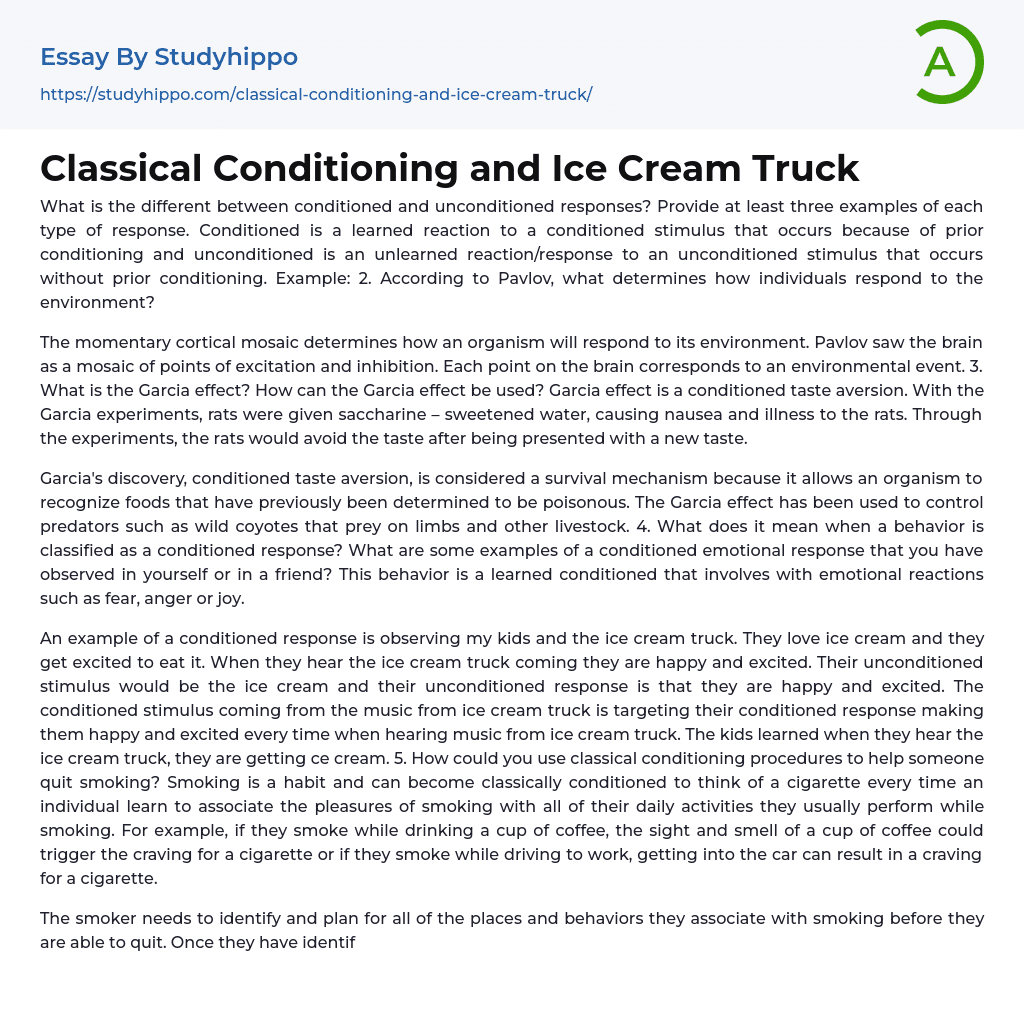What is the different between conditioned and unconditioned responses? Provide at least three examples of each type of response. Conditioned is a learned reaction to a conditioned stimulus that occurs because of prior conditioning and unconditioned is an unlearned reaction/response to an unconditioned stimulus that occurs without prior conditioning. Example: 2. According to Pavlov, what determines how individuals respond to the environment?
The momentary cortical mosaic determines how an organism will respond to its environment. Pavlov saw the brain as a mosaic of points of excitation and inhibition. Each point on the brain corresponds to an environmental event. 3. What is the Garcia effect? How can the Garcia effect be used? Garcia effect is a conditioned taste aversion. With the Garcia experiments, rats were given saccharine – sweetened water, cau
...sing nausea and illness to the rats. Through the experiments, the rats would avoid the taste after being presented with a new taste.
Garcia's discovery, conditioned taste aversion, is considered a survival mechanism because it allows an organism to recognize foods that have previously been determined to be poisonous. The Garcia effect has been used to control predators such as wild coyotes that prey on limbs and other livestock. 4. What does it mean when a behavior is classified as a conditioned response? What are some examples of a conditioned emotional response that you have observed in yourself or in a friend? This behavior is a learned conditioned that involves with emotional reactions such as fear, anger or joy.
An example of a conditioned response is observing my kids and the ice cream truck. They love ice cream and they get excited to eat it
When they hear the ice cream truck coming they are happy and excited. Their unconditioned stimulus would be the ice cream and their unconditioned response is that they are happy and excited. The conditioned stimulus coming from the music from ice cream truck is targeting their conditioned response making them happy and excited every time when hearing music from ice cream truck. The kids learned when they hear the ice cream truck, they are getting ce cream. 5. How could you use classical conditioning procedures to help someone quit smoking? Smoking is a habit and can become classically conditioned to think of a cigarette every time an individual learn to associate the pleasures of smoking with all of their daily activities they usually perform while smoking. For example, if they smoke while drinking a cup of coffee, the sight and smell of a cup of coffee could trigger the craving for a cigarette or if they smoke while driving to work, getting into the car can result in a craving for a cigarette.
The smoker needs to identify and plan for all of the places and behaviors they associate with smoking before they are able to quit. Once they have identified all the things that trigger them in the craving. They will have to change their daily routine, so they can eliminate the connection between the triggers and smoking. 6. Can Guthrie’s techniques for breaking bad habits be applied to serious problems in a clinical setting? Why or why not?
Yes Guthrie’s technique in the three methods for breaking habits involved with the threshold method, fatigue method and incompatible response method can be applied to
a clinical setting. All of these methods consist in presenting the cues of an undesirable action and seeing to it that the action is not performed. With Guthrie’s techniques, an individual is entails to getting use to the new habit and also have the ability to repeat the bad habit over and over until they get sick of it. They also will be paring an unpleasant behavior with a more pleasant behavior.
Guthrie also uses punishment in breaking bad habits. For example if a person is being punish for a bad habit, that person will try to change their habits. 7. How does Guthrie’s theory of learning differ from Thorndike’s? According to Guthrie, all learning was a consequence of association between a particular stimulus and response. Guthrie argued that stimuli and responses affect specific sensory-motor patterns; what are learned are movements, not behaviors. 8. According to Estes, how is one learning experience generalized to nother? 9. According to Estes’ model of learning, what role does reinforcement play in learning? According to Estes’ model of learning, reinforcement does not relate to the learning of behavior but he views the role of reinforcement as stresses of the information that it provides to the organism. He believed the reinforcements were learned also, as an outcome of some response. In this view, reinforcement and punishment are performance variables since they determine how material already learned will manifest itself in behavior
- Interpretation essays
- Plagiarism essays
- Analogy essays
- Learning English essays
- Abnormal Psychology essays
- Abraham Maslow essays
- Attachment Theory essays
- Authority essays
- Behaviorism essays
- Classical Conditioning essays
- Cognitive Psychology essays
- Counseling essays
- Developmental Psychology essays
- Educational Psychology essays
- Erik Erikson essays
- Family Therapy essays
- Jean Piaget essays
- Maslow's Hierarchy Of Needs essays
- Mental Health essays
- Operant Conditioning essays
- Personality Psychology essays
- Positive Psychology essays
- Psychoanalysis essays
- Psychotherapy essays
- Sigmund Freud essays
- Social Psychology essays
- Stanford Prison Experiment essays
- Supersize Me essays
- Coaching essays
- Critical Thinking essays
- homework essays
- Learning essays
- Library essays
- Listening essays
- Literacy essays
- Mentor essays
- Physical Education essays
- Project essays
- Reading essays
- Research essays
- Sex Education essays
- Social Studies essays
- Standardized Testing essays
- Study Plan essays
- Teaching essays
- Adult essays
- Aggression essays
- Altruism essays
- Archetype essays
- Behavior essays




